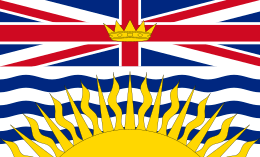Leader of the Opposition (British Columbia)
The Leader of the Opposition (French: Chef de l'Opposition) in British Columbia is the MLA in the Legislative Assembly of British Columbia who leads the political party recognized as the Official Opposition. This position generally goes to the leader of the largest party in the Legislative Assembly that is not in government.
References
- ↑ Legislative Library of British Columbia, Party Leaders in British Columbia 1900-, 2000, updated 2005
- ↑ Lost his seat in the 1912 general election that wiped out the Liberals. No Opposition leader until Brewster won a by-election in 1916.
- ↑ Pooley was the Conservative Party's House Leader due to the defeat of William John Bowser. In 1926 Simon Fraser Tolmie was elected Conservative leader but he did not seek a seat in the legislature until the 1928 provincial election which his party won
- ↑ Connell was exeplled from the CCF in 1936 for opposing party policy. He and three other CCF MLAs formed the "Social Reconstructive" party. With a total of 4 MLAs compared to 3 remaining in the CCF, Connell's new party was the second largest in the legislature allowing him to retain the title of Leader of the Official Opposition
- ↑ Anscomb's Conservatives had been part of a coalition government with the Liberals until late 1951 when the Liberals decided to terminate the arrangement and Premier John Hart dropped his Conservative ministers from Cabinet. The Tories moved to the opposition benches and displaced the CCF to form the Official Opposition from February 1952 until the June 1952 provincial election
- ↑ The CCF became the NDP in 1961 as a result of the creation of the federal New Democratic Party
- ↑ Barrett lost his seat in the December 1975 general election and re-entered the legislature through a June 1976 by-election. William Stewart King acted as Leader of the Opposition in the house in the interim. Barrett continued as leader of the party during this period
- ↑ Although Premier Campbell refused to recognize the NDP as an official party since it lacked the number of seats required for official party status, the Speaker recognized MacPhail as Opposition Leader and ensured the NDP received the resources and funding due to it as an opposition.
This article is issued from
Wikipedia.
The text is licensed under Creative Commons - Attribution - Sharealike.
Additional terms may apply for the media files.
